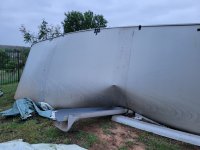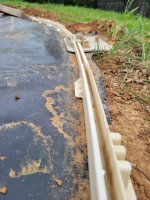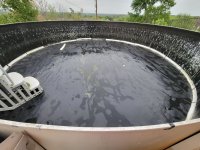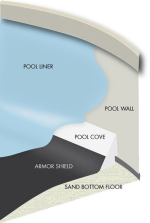Hey everyone,
I went to replace my liner the other day, after reading/watching numerous "you can do this, it's easy" tutorials. *eye roll*. After spending most of the day just trying to get the pool empty, due to lacking the proper pumping equipment, realizing my pump filter had a crack in it from winter, syphoning out using my vacuum hose, etc, I finally got the liner out, put the rails back on the walls. Didn't realize winds were picking up that night, and it collapsed in the middle of the night. Not a single tutorial said anything about that lol.
Anyway, the next picture shows where it creased. After rolling back up, it's just a single point where it is bent, no other damage to the wall. I was thinking, the water is mostly pressing outward on the walls, but with the upper part having bent inward like this, I suspect any pressure pulling on the top of the rail (from the liner or kids sitting on it), will pull this over pretty easily. But I also think the force from the water inside would also be way stronger and push it back out at a much higher pressure. I don't want to have the pool full of water before figuring out which. I was thinking I could get a fairly thick steel sheet, maybe 6 to 12 inches tall, and 4 inches wide, and secure it to the inside or outside of the wall with lots of rivets, thereby putting the strength back in that section.

Another thought I had was to maybe build the sand base up a little more right in that area, so the liner doesn't stretch as much and pull the top down. That would maybe give it time for the upper part of the pool to fill with water. One thing I have to my advantage is that the crease is fairly low down on the wall. Appreciate thoughts on either of these approaches.
All of that aside, it's probably a good thing this happened. The wall facing my downslope was about 1.75 inches low, and after having the wall out, I can see now that it appears they took some very unusual approaches to installing this pool initially. It looks like the ground rail was sitting up higher than the inside and outside in some places (like it's on a lip). In one place, I found the rail was at a steep angle, and the wall had come out. At an angle, because the ground under it either eroded or was not there to begin with, because they built up a tiny burm to install the rail on...
Also, they used what looks like shower liner, and I can't find anything or anyone suggesting such a thing, and some sites saying never use plastic, because the water doesn't drain. Indeed, when I was trying to remove the liner, I had so much trouble getting the last inch of water out, I thought I'll just cut the liner. Did that, but the water just flooded the inside on the pastic and did not drain at all. So I very much see why plastic seems bad, but should I keep it and just add a real pool pad on top?

They placed the entire ground rail on top of the plastic as well. So, it looks like this. They leveled the ground, then dug out the middle area, filled it with sand pretty close to the edge but let it taper downward at the edges, then covered the sand and the surrounding ground with plastic, then installed the rail on top of the plastic (the rail was below the top of the sand). You can kind of see this in the picture above.
As for fixing this mess, I'm pulling the sand back a bit, pulling the plastic up, leveling the area where the ground rail will be on both sides for a good 4 inches, will then put the wall back up, place the foam coves all around, pull the sand back to the edge of the coves, and return the plastic.
Oh, and none of my support braces had concrete blocks or any kind of footing under them, so I guess I should add that as well.
Additionally, there was no gravel or rocks around the outside of the pool. There was only about 4 inches of clearance before the ground started rising on the upper sides of the pool. So I'm planning to give myself more like a foot to install some gravel and improve drainage. This is an aluminum wall, so it should last for a long time. Although this is what the inside looked like before it collapsed, which I'm not sure what this white stuff means:

Why do I get the impression that I paid a lot of money for a very minimum job.
The blue tarp covers about a 3 foot wall of concrete blocks and rocks. That was fun digging out around the pool. Probably need to rethink that as well...

I went to replace my liner the other day, after reading/watching numerous "you can do this, it's easy" tutorials. *eye roll*. After spending most of the day just trying to get the pool empty, due to lacking the proper pumping equipment, realizing my pump filter had a crack in it from winter, syphoning out using my vacuum hose, etc, I finally got the liner out, put the rails back on the walls. Didn't realize winds were picking up that night, and it collapsed in the middle of the night. Not a single tutorial said anything about that lol.
Anyway, the next picture shows where it creased. After rolling back up, it's just a single point where it is bent, no other damage to the wall. I was thinking, the water is mostly pressing outward on the walls, but with the upper part having bent inward like this, I suspect any pressure pulling on the top of the rail (from the liner or kids sitting on it), will pull this over pretty easily. But I also think the force from the water inside would also be way stronger and push it back out at a much higher pressure. I don't want to have the pool full of water before figuring out which. I was thinking I could get a fairly thick steel sheet, maybe 6 to 12 inches tall, and 4 inches wide, and secure it to the inside or outside of the wall with lots of rivets, thereby putting the strength back in that section.

Another thought I had was to maybe build the sand base up a little more right in that area, so the liner doesn't stretch as much and pull the top down. That would maybe give it time for the upper part of the pool to fill with water. One thing I have to my advantage is that the crease is fairly low down on the wall. Appreciate thoughts on either of these approaches.
All of that aside, it's probably a good thing this happened. The wall facing my downslope was about 1.75 inches low, and after having the wall out, I can see now that it appears they took some very unusual approaches to installing this pool initially. It looks like the ground rail was sitting up higher than the inside and outside in some places (like it's on a lip). In one place, I found the rail was at a steep angle, and the wall had come out. At an angle, because the ground under it either eroded or was not there to begin with, because they built up a tiny burm to install the rail on...
Also, they used what looks like shower liner, and I can't find anything or anyone suggesting such a thing, and some sites saying never use plastic, because the water doesn't drain. Indeed, when I was trying to remove the liner, I had so much trouble getting the last inch of water out, I thought I'll just cut the liner. Did that, but the water just flooded the inside on the pastic and did not drain at all. So I very much see why plastic seems bad, but should I keep it and just add a real pool pad on top?

They placed the entire ground rail on top of the plastic as well. So, it looks like this. They leveled the ground, then dug out the middle area, filled it with sand pretty close to the edge but let it taper downward at the edges, then covered the sand and the surrounding ground with plastic, then installed the rail on top of the plastic (the rail was below the top of the sand). You can kind of see this in the picture above.
As for fixing this mess, I'm pulling the sand back a bit, pulling the plastic up, leveling the area where the ground rail will be on both sides for a good 4 inches, will then put the wall back up, place the foam coves all around, pull the sand back to the edge of the coves, and return the plastic.
Oh, and none of my support braces had concrete blocks or any kind of footing under them, so I guess I should add that as well.
Additionally, there was no gravel or rocks around the outside of the pool. There was only about 4 inches of clearance before the ground started rising on the upper sides of the pool. So I'm planning to give myself more like a foot to install some gravel and improve drainage. This is an aluminum wall, so it should last for a long time. Although this is what the inside looked like before it collapsed, which I'm not sure what this white stuff means:

Why do I get the impression that I paid a lot of money for a very minimum job.
The blue tarp covers about a 3 foot wall of concrete blocks and rocks. That was fun digging out around the pool. Probably need to rethink that as well...



 Sorry it had to be under such circumstances.
Sorry it had to be under such circumstances. 